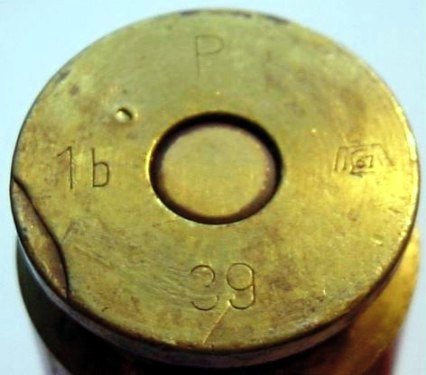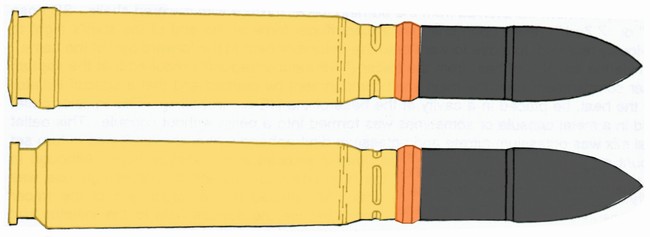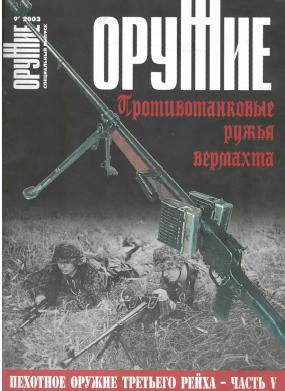Well…Tony is here ?
That is a good news.

Well…Tony is here ?
That is a good news.
German ( and Italian) weapons defending the Tobruk coast, in the video is posible to see ( even briefly) a 20 mm Solo S-18-1000 in action.
The Pzb 39 in practice shooting, the muzzle velocity of this anti-armor rifle was 1180 m/s.

And a rare color pic, in this the team gunner with a loader/spotter seems to be used.

Modern color shots of the Pzb 39 7,92 mm antiarmor rifle, the russian reenactor are dressed with the spring SS camo uniform.




Solothurn , introduced the self-loading S18-100 series (the numbers of the variants went up to S18-500) in a unique 20 x 105B calibre. The gun was gas-operated and this round was later used to develop an aircraft cannon
Some correction needed here, the Solo S-18-100 is NOT gas operated but short recoil operated.
20x105 mm cartrigdes:


Aditional images of the Solothurn S-18-100 20mm AT rifle:


Barrel jacket, the flutted part marked the recoil lenght.


continue from page 2…
Muzzle brake. (mundungbremse)


Graduation in the sight.

Well Panzersnacker you gave the viewers alot of good information and pictures. I was wondering what AntiTank rifle you perfer to use on the German side on your thread.
What antitank?
The Panzerfaust 60.
What antitank rifle ?
hmmm…dunno, so many to choose from, I guess I would use one of the 15-20 mm caliber rifles.
I have been sent an extract from official minutes of a British Committee (I’m not sure what, probably the Small Arms Committee) concerning British tests of the Solothurn S18-100 in 1934. Apparently it had been malfunctioning and they felt that considerable redesign of the firing pin and sear would be needed to make it satisfactory. Nonetheless, they decided to order another 3,000 rounds of ammo from ICI for further tests.
As to what happened next, I have no idea!
Tony Williams: Military gun and ammunition website and discussion forum
Probably they felt that the Stanchion gun was a more practical gun. ( but as effective)
It was certainly much more portable, but was no more effective than the WW1 13mm Mauser M1918. A considerable waste of effort IMO.
By far the most effective of the WW2 anti-tank rifles was the Russian 14.5mm PTRD. It had as much penetration as the biggest 20mm AT guns (the Solothurn S18-1000 and Lahti L39) while being much more portable.
Tony Williams: Military gun and ammunition website and discussion forum
Teorically a 20 mm rifle shooting tusgen core ammo surpassed both russian designs. Now I think that the pzg 40 bullet was never used in the Solos and Lathis rifles.

There was also several 15 mm experimental german rifles wich were as effective as the russian , but none entered in large scale production.
Pzb 39 deployed in the early stages of barbarossa, those were trown away after the first encounters with the T-34 and KV.

Wow , nice picture, the shooter is a british one right ?
I dont think so,the uniforms…,probably continental…Swiss,Hungarian…,i dont know. …but it is a ass kicking picture of a SOLOTHURN A/T rifle.
…but it is a ass kicking picture of a SOLOTHURN A/T rifle.
You are right, I just cant identify that uniform.
Experimental 7,92x94mm rifles.
The germans were quite unsatisfied with the performance of their tank rifles. It was obvious that other tank rifles were to be produced if this weapon type was to have any practical use. Several projects were undertaken in 1940 by several companies, all using the Patrone 318.

Gustloff-Werke presented two self-loading AT rifles - model 42 (later known as PzB.40 G) and model 44. Rifle model 42 had 5 different variations. It was gas-operated. Both models, capable only of semi-auto fire, had different mechanisms of locking the barrel. In one case it was wedge locking and in other case it was done by lever. Both models were magazine-feed from 8-round magazine.
Gustloff PzB 40.
Magazine receiver was made on the left side of the rifle’s body. For decreasing the size of a rifle in stowed position (due to request from para forces command), rifle’s butt folded to the left side, decreasing the overall length from 1660mm to 1460mm. Barrel length - 1085mm.
Practical fire rate of Gustloff-werke rifles was up to 32 shots per minute, with an initial bullet speed of 1150m/s.
Effective fire range was no more than 300m. First model 42 weighted 18kg, second model 44 - 13.5kg. In these rifles were used components from other small arms, which production was already mastered, for example, the pivot-frame and butt from MG.34.
The Waffenfabrik Carl walther in Zella-Mehlis built the Modell 40 / PzB 40 W, a semiautomatic weapon with a curved magazine for 8 rounds.
Pzb 40 Walther.
Another Self-loading AT rifle , the model 41 was made by firm Mauser-Werke from town Oberndorf-am-Nekkar. It was gas-operated. . It was magazine-feeded, sector-type magazine contained 8 rounds and was inserted into receiver from left side.
Lock was capable of only semi-automatic fire with practical fire rate of 32 shots per minute. The rifle was partially made using punched metallic components. Overall length was 1670mm, barrel was 1085mm long; rifle weighted 12.5kg.
Mauser M41.
H. Krieghoff made not less interesting AT rifle model 43 (also known as PzB.40 K). Zul armsmasters presented seven prototypes with differences. They were gas-operated with wedge barrel locking. Most part of rifle components (excluding barrel and lock), was made out of steel sheet by punching. 8-round box-shaped magazine was fastened on the left side of the rifle. Rifle weighted 14kg, it’s overall length was 1570mm (1300mm with folded butt), while the barrel itself was 1150mm long.
There were thorough many-sided tests of new AT rifles which took place in october 1940 for finding out which rifle is best.—
In the end all there rifles were deprived to enter in large scale production due the increase in armor achieved by allied tanks designs, the 8mm caliber despite his ultra velocity was no more competitive.
Sources:
http://www.geocities.com/Augusta/8172/panzerfaust6.htm
http://www.lexikon-der-wehrmacht.de/Waffen/panzerbuchsen-R.htm
